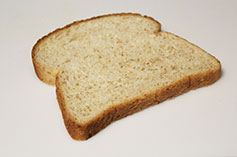
Bread Slices
Coming Soon...

Ginger
Native to Southeastern Asia, Ginger is popularly used as a spice and medicine in both eastern and western cultures. Ginger was used by ancient Romans and later, after the fall of Roman Empire, was traded in Europe by Arabs who took over the spice trade. Ginger became very expensive like other spices, and in medieval times, was traded in preserved form to make sweet treats.
For many years, ginger has been used to flavor a wide variety of food, from meats and sausages to fish and vegetables, and various curries as well as drinks and desserts. Fresh ginger can be used as sliced, crushed, or as paste.
Ginger has antioxidant and anti-inflammatory properties; therefore, it’s used in traditional medicine to cure a variety of ailments, such as, gastrointestinal distress, motion sickness, arthritis, and cold and flu. Cooking food with small quantity of ginger on a regular basis also adds to health benefits.
The distinct flavor and medicinal property of ginger comes from gingerols, shogaols, and zingerone. Fresh ginger contains gingerol an anti-inflammatory compound that is believed to help in reducing osteoarthritis or rheumatoid arthritis pain, if consumed on a regular basis. It may also prevent growth of certain cancer. Gingerol is transformed into shogaols when dried and cooked. Also, when ginger is cooked gingerol and shogaols is transformed into zingerone. Due to the presence of zingerone, food cooked with ginger has a sweet and spicy flavor. The anti-inflammatory and antioxidant properties of zingerone help in prevention and cure of many medical problems. Dry ginger alone has strong flavor due to shogaols used in many medicines as well as compliments cookies, cakes, and candies recipes, and tea and drinks.
In addition to the use for culinary and medicinal purposes, ginger is also used to fragrance many soaps and cosmetics.
Ginger is sold in many forms in supermarkets, such as fresh, dried, powdered, preserved, crystallized, and as oil. You will find ginger paste, a popular way of using ginger to make curries in Asian countries, in Asian and South Asian grocery stores. Be sure to use ginger in the recipe in the form it’s advised. For example, if a recipe calls for fresh ginger, it cannot be replaced with dry or powdered or other types. Each form of ginger has a distinct taste and different purpose.
Ginger is best stored as whole and unpeeled in a sealed plastic bag in refrigerator. If part of the ginger has been cut or peeled, be sure to dry it before storing. Other forms of ginger are mainly packaged and need to be stored as per instructions by the seller.
For many years, ginger has been used to flavor a wide variety of food, from meats and sausages to fish and vegetables, and various curries as well as drinks and desserts. Fresh ginger can be used as sliced, crushed, or as paste.
Ginger has antioxidant and anti-inflammatory properties; therefore, it’s used in traditional medicine to cure a variety of ailments, such as, gastrointestinal distress, motion sickness, arthritis, and cold and flu. Cooking food with small quantity of ginger on a regular basis also adds to health benefits.
The distinct flavor and medicinal property of ginger comes from gingerols, shogaols, and zingerone. Fresh ginger contains gingerol an anti-inflammatory compound that is believed to help in reducing osteoarthritis or rheumatoid arthritis pain, if consumed on a regular basis. It may also prevent growth of certain cancer. Gingerol is transformed into shogaols when dried and cooked. Also, when ginger is cooked gingerol and shogaols is transformed into zingerone. Due to the presence of zingerone, food cooked with ginger has a sweet and spicy flavor. The anti-inflammatory and antioxidant properties of zingerone help in prevention and cure of many medical problems. Dry ginger alone has strong flavor due to shogaols used in many medicines as well as compliments cookies, cakes, and candies recipes, and tea and drinks.
In addition to the use for culinary and medicinal purposes, ginger is also used to fragrance many soaps and cosmetics.
Ginger is sold in many forms in supermarkets, such as fresh, dried, powdered, preserved, crystallized, and as oil. You will find ginger paste, a popular way of using ginger to make curries in Asian countries, in Asian and South Asian grocery stores. Be sure to use ginger in the recipe in the form it’s advised. For example, if a recipe calls for fresh ginger, it cannot be replaced with dry or powdered or other types. Each form of ginger has a distinct taste and different purpose.
Ginger is best stored as whole and unpeeled in a sealed plastic bag in refrigerator. If part of the ginger has been cut or peeled, be sure to dry it before storing. Other forms of ginger are mainly packaged and need to be stored as per instructions by the seller.
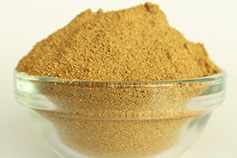
Coriander Powder
Coriander, also known as cilantro and Chinese parsley, is an herb native to Southeastern Europe and is cultivated in Egypt, Middle East, China, India, and Turkey. Coriander powder is made by grinding the dried or roasted seeds of coriander plant. The seeds are small (2-3 mm long), oval in shape, and light brown in color. Coriander powder provides mild-nutty flavor and aroma to many savory and sweet dishes.
Due to its mild-nutty taste and aroma, coriander powder is an essential ingredient in many vegetable and meat curry preparations and barbecue rubs and sauces. It is also added to waffle and pancake mixes and dessert sauces for an enhanced taste.
The presence of coriander powder in food stimulates the taste buds and helps digestion. Including coriander in your diet has many health benefits. It is a great source of potassium, iron, vitamin A, K and C, folic acid, magnesium, and calcium. It is a good source of antioxidants and helps detoxify the body.
Coriander powder is easily available in grocery stores or can be made at home by grinding the coriander seeds. To make coriander powder at home:
Due to its mild-nutty taste and aroma, coriander powder is an essential ingredient in many vegetable and meat curry preparations and barbecue rubs and sauces. It is also added to waffle and pancake mixes and dessert sauces for an enhanced taste.
The presence of coriander powder in food stimulates the taste buds and helps digestion. Including coriander in your diet has many health benefits. It is a great source of potassium, iron, vitamin A, K and C, folic acid, magnesium, and calcium. It is a good source of antioxidants and helps detoxify the body.
Coriander powder is easily available in grocery stores or can be made at home by grinding the coriander seeds. To make coriander powder at home:
- Either dry the coriander seeds in sun for a couple of days or slightly roast the seeds without oil in a pan. Roasting the seeds before grinding enhances the taste and aroma of the coriander powder. Also, drying in sun or roasting removes moisture from the seeds and adds crispness, which helps in powdering the seeds.
- Let the seeds cool and then grind them in a spice grinder. You can also use a coffee grinder for grinding spices; however it’s not recommended to use the same grinder for grinding spices and coffee.
- Store coriander powder in a tightly sealed container in a cool, dark, and dry place. If you are making coriander powder at home, cool it down before storing. It usually last for 4-6 months at room temperature. Refrigerate it for a longer shelf life of 18-24 months.
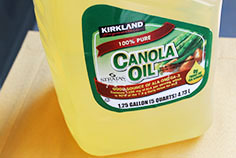
Canola Oil
Coming Soon...

Salt
Salt is a mineral composed of a chemical compound called sodium chloride. It is essential for human body to regulate fluid balance and to control function of nerves and muscles. Human body cannot produce its own salt and depends on various sources of salt in food for necessary daily intake.
In addition to being just a diet supplement, salt helps in extracting the real flavors of savory as well as sweet dishes. No other seasoning has been found so fulfilling to replace salt. However, the overuse of salt results into a lot of health problems, such as hypertension, heart disease, and strokes. Use salt mildly in your food to you can enjoy its goodness.
In addition to being just a diet supplement, salt helps in extracting the real flavors of savory as well as sweet dishes. No other seasoning has been found so fulfilling to replace salt. However, the overuse of salt results into a lot of health problems, such as hypertension, heart disease, and strokes. Use salt mildly in your food to you can enjoy its goodness.

Water
Coming Soon...

Potatoes
Coming Soon...
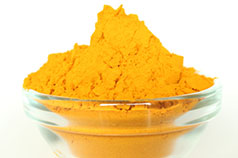
Turmeric Powder
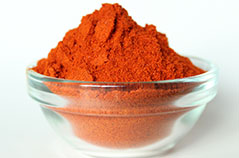
Red Chili Powder
Red chili powder is made by grinding dried deep red-brown thai chili peppers. Native to central and South America, red thai chili peppers were introduced to South Asia in 1500s and now India is the largest producer of these peppers in the world. Either in powdered or whole form, the chili peppers are used to add extra heat and spiciness to the dishes, which is due to the presence of a compound called capsaicin.
Red chili powder is a widely used spice for preparing a variety of curries, soups, stews, marinades, sauces, and dry rubs for barbecue. It is also used to flavor some sweet dishes such as cakes, brownies, truffles, and chocolates.
Red chili powder is a healthy seasoning. It contains significant amount of vitamin A and C, and beta carotenoids (a red-orange pigment that acts as an antioxidant and converts into vitamin A). It also helps to detoxify our body.
When purchasing red chili powder at store, look for the bright red colored powder for best taste. For making red chili powder at home:
Red chili powder is available in Indian and South Asian grocery stores. Some of the popular brands of red chili powder are Nirav, Deep, SWAD, Spicy World, and Everest. You may also find it in supermarkets or gourmet markets. It is available at online grocery stores such as amazon.com, where you will be able to choose from several brands.
Red chili powder is a widely used spice for preparing a variety of curries, soups, stews, marinades, sauces, and dry rubs for barbecue. It is also used to flavor some sweet dishes such as cakes, brownies, truffles, and chocolates.
Red chili powder is a healthy seasoning. It contains significant amount of vitamin A and C, and beta carotenoids (a red-orange pigment that acts as an antioxidant and converts into vitamin A). It also helps to detoxify our body.
When purchasing red chili powder at store, look for the bright red colored powder for best taste. For making red chili powder at home:
- Buy dry (not fresh) whole red thai chili peppers and remove the stems.
- Further dry the chili peppers in sun for a couple of days or slightly roast them for 2-3 minutes, without oil in a pan. Drying or roasting removes moisture from the chili peppers and adds extra crispness, which is required to powder them. Roasting the chili peppers enhances its flavor and aroma.
- Let the dried or roasted chili peppers cool down and then grind to a fine powder in a spice grinder. You can also use a coffee grinder for this purpose; however, the coffee grinder should be used for grinding spices only. It is not advisable to use the same grinder for spices and coffee.
Red chili powder is available in Indian and South Asian grocery stores. Some of the popular brands of red chili powder are Nirav, Deep, SWAD, Spicy World, and Everest. You may also find it in supermarkets or gourmet markets. It is available at online grocery stores such as amazon.com, where you will be able to choose from several brands.
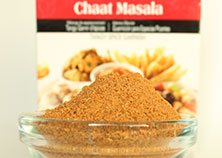
Chaat Masala
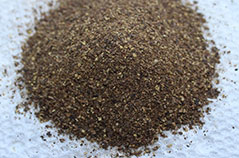
Black Pepper Powder
Share your thoughts and questions!


